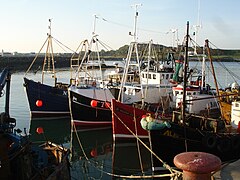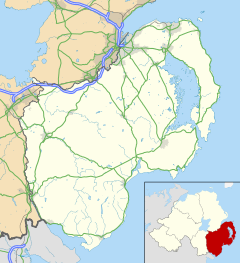Ardglass
Ardglass
|
|
|---|---|
 Ardglass Harbour, May 2009 |
|
| Ardglass shown within County Down | |
| Population | 1,668 |
| • Belfast | 34.1 mi |
| District | |
| County | |
| Country | Northern Ireland |
| Sovereign state | United Kingdom |
| Post town | ARDGLASS |
| Postcode district | BT30 |
| Dialling code | 028 |
| EU Parliament | Northern Ireland |
| UK Parliament | |
| NI Assembly | |
Ardglass (from Irish Ard Ghlais, meaning 'green height') is a coastal fishing village, townland (of 321 acres) and civil parish in County Down, Northern Ireland, in the historic barony of Lecale Lower. It is still a relatively important fishing harbour. It is situated on the B1 Ardglass to Downpatrick road, about 6 miles (11 kilometres) to the south east of Downpatrick, in the Lecale peninsula on the Irish Sea. It had a population of 1,668 people in the 2001 Census, and is located within the Down District Council area.
The village is a commuter centre for workers in Downpatrick and Belfast, a seaside resort and a local service centre providing housing and a variety of shops and services largely concentrated in Castle Place, Quay Street, Kildare Street and Bath Street. A Conservation area was designated in Ardglass in 1996, focused on its early 19th century street pattern. The village has eight archaeological sites within the area and another two nearby. There are a number of listed properties located on Castle Place, Kildare Street and The Crescent. St Nicholas's Church, King's Castle, Ardglass Castle, Isabella Tower, the disused railway station, the North Pier and the inner Dock are also listed.
Ardglass grew from a place of little note in the 13th century to a modestly prosperous port in the 15th century. It was an important town and port in the Middle Ages, but no harbour works seem to have been constructed until after 1812. Then William Ogilvie, who had acquired the Ardglass estate, had a harbour built. Further extensions to the pier and a lighthouse were made, but in 1838 a great storm undermined the lighthouse which fell into the sea along with the end of the pier. Work on the piers was completed by 1885 and they remain in use to this day.
...
Wikipedia

